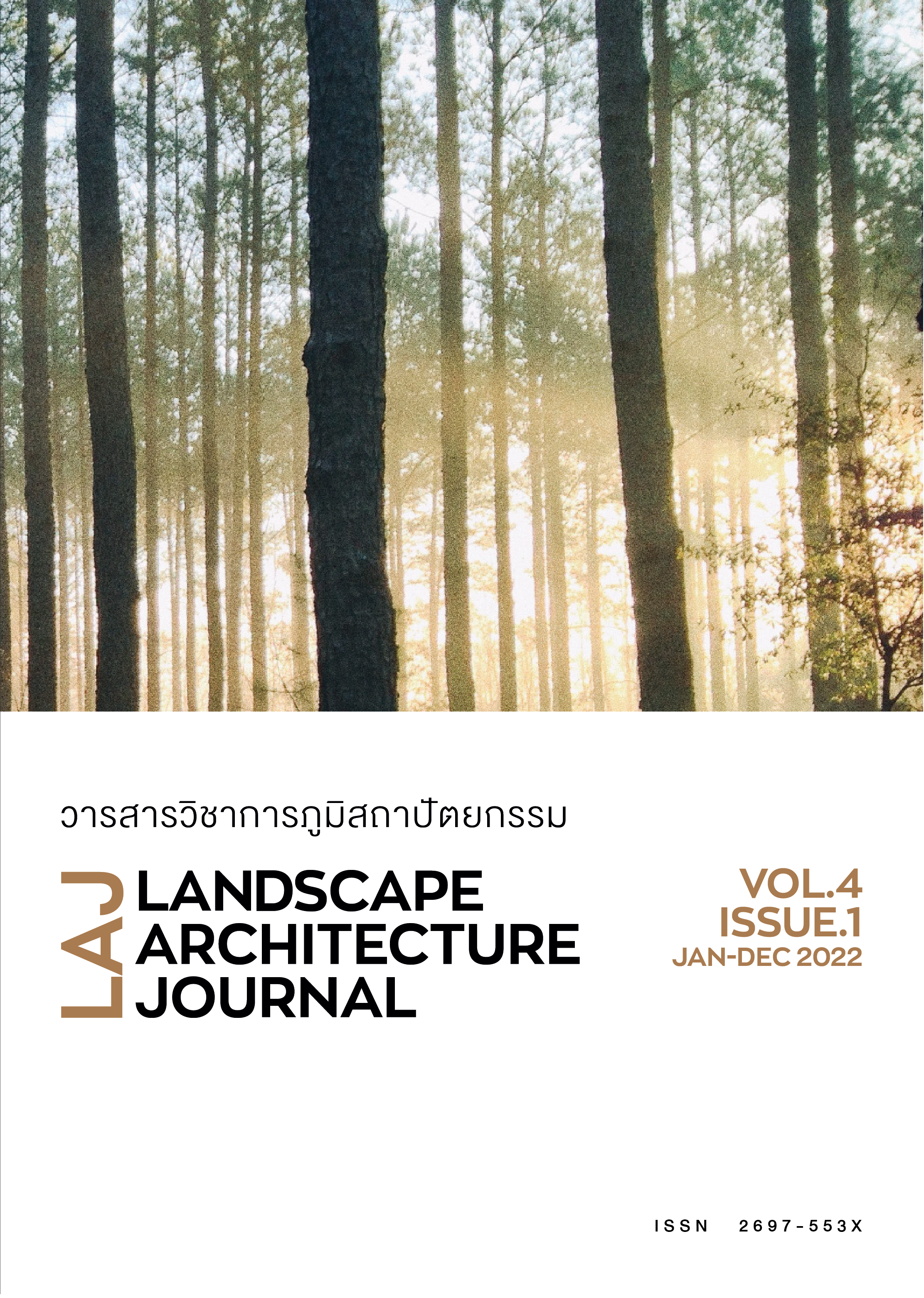Open Space in Old Town of Nakhon Ratchasima and Its Adjacent Areas
Main Article Content
Abstract
The main objective of this research is to study the characteristics of available open space system and how it affected urban areas in the old town of Nakhon Ratchasima. The studied theories are used to categorize types of available open spaces in the old town and adjacent areas, which consists of 5 types as follows: 1) circulations or roads, 2) parking spaces, 3) water resources, 4) recreation spaces, and 5) wasted spaces. The analysis includes characteristics, types, locations, access, and utilization reflecting the relationships between people and open spaces. This finally leads to guidelines on solution and promotion of available open space system by collecting data from satellite images, surveys, and photography for taking notes, location specification, and characteristics of open spaces in order to record as supporting evidences for research descriptions. The results reveal that the current open space system in term of hardscape circulations was divided as grid pattern that facilitated access to different types of open spaces in many spots. People used cars as the main vehicle because they were more convenient than pedestrian circulations. As a consequence, open space system facilitated cars, and thus this caused problems of circulations or insufficient roads to support the number of cars that finally leads to traffic congestion in the future and urban air pollution. This caused unlivable and unshady city. In addition, using cars caused lack of interaction among people and tendency to lack of liveliness of the town as well as people in the future. The solutions are suggested as next. Road sizes should be reduced while shadiness from trees should be increased. For the improvement of wasted spaces that are usually covered by plants in the middle of each block, these spaces should be developed as the network connection among urban parks. This will create natural environment and reduce any possible pollutions. Also, people can access more conveniently. Promoting more pleasant pedestals can also attract people to live, which can finally lead to new businesses that help promote economy and good quality of life.
Article Details

This work is licensed under a Creative Commons Attribution-NonCommercial-NoDerivatives 4.0 International License.
References
กาญจน์ นทีวุฒิกุล. (2550). ตรรกะของการใช้พื้นที่ว่างสาธารณะอย่างอเนกประโยชน์ในเมืองเชียงใหม่. (วิทยานิพนธ์ปริญญาดุษฎีบัณฑิต). จุฬาลงกรณ์มหาวิทยาลัย, กรุงเทพฯ.
กรองกาญจน์ อัครเอกฒาลิน. (2555). ความเหมาะสมในการใช้ประโยชน์พื้นที่เปิดโล่งคูเมืองนครราชสีมา. (วิทยานิพนธ์ปริญญามหาบัณฑิต). มหาวิทยาลัยศิลปากร, กรุงเทพฯ.
ไขศรี ภักดิ์สุขเจริญ. (2547). วาทกรรมของเมือง ผ่านโครงสร้างเชิงสัณฐาน, วารสารวิชาการคณะสถาปัตยกรรมศาสตร์, (2), 63-76.
ไขศรี ภักดิ์สุขเจริญ, (2562). พื้นที่เมืองและความเป็นสาธารณะ. กรุงเทพฯ: โรงพิมพ์ลายเส้น พับบลิชชิ่งจำกัด.
นพมาศ ทับแสง. (2561). อิทธิพลของพื้นที่สีเขียวที่มีต่อมลภาวะฝุ่นละอองในเขตชุมชนเมือง กรณีศึกษาชุมชนเมืองสมุทรปราการ. (วิทยานิพนธ์ปริญญามหาบัณฑิต). มหาวิทยาลัยธรรมศาสตร์, กรุงเทพฯ.
นิธิ ลิศนันท์. (2559). แนวทางที่ส่งเสริมศักยภาพของพื้นที่สาธารณะในเมืองเก่านครราชสีมา, วารสารวิจัยและสาระสถาปัตยกรรม/การผังเมือง (JARS), 13(2), 99-122.
พรทิพย์ กิ้มนวน. (2560). คุณลักษณะและรูปแบบการใช้งานพื้นที่ว่างสาธารณะในย่านพาณิชย์กรรมเมืองตรัง. (วิทยานิพนธ์ปริญญามหาบัณฑิต). มหาวิทยาลัยศิลปากร, กรุงเทพฯ.
รังสิมา กุลพัฒน์, จิตรมณี ดีอุดมจันทร์, และมาริสา หิรัญตียะกุล. (2562). เมืองนครราชสีมา: การศึกษาเมืองเก่าผ่านประวัติศาสตร์การตั้งถิ่นฐานและมรดกทางสถาปัตยกรรม. วารสารหน้าจั่ว คณะสถาปัตยกรรม มหาวิทยาลัยศิลปากร, (16), 1.
สลิดทิพย์ รุ่งเรือง. (2554). ที่ว่าง ที่สร้างให้เกิดความยั่งยืนทางสังคม: กรณีศึกษาความสัมพันธ์ของพื้นที่ว่าง และทางปฏิบัติการทางสังคม ของพื้นที่เมืองเก่าลำพูน ตำบลในเมืองจังหวัดลำพูน. (วิทยานิพนธ์ปริญญามหาบัณฑิต). มหาวิทยาลัยศิลปากร, กรุงเทพฯ.
ศุภชัย ชัยจันทร์, และ ณรงพน ไล่ประกอบทรัพย์. (2559). แนวคิดสาธารณะของพื้นที่สาธารณะในเมือง. วารสารวิชาการ คณะสถาปัตยกรรม มหาวิทยาลัยของแก่น, 15(2), 74-82.
สุพักตรา สุทธสุภา. (2540). พื้นที่เปิดโล่ง: องค์ประกอบในเมือง. วารสารหน้าจั่ว คณะสถาปัตยกรรม มหาวิทยาลัยศิลปากร, (15), 121-126.
สำนักงานนโยบายและแผนการขนส่งและจราจร. (2560). โครงการศึกษาแผนแม่บทจราจรและแผนแม่บทพัฒนาระบบขนส่งสาธารณะ ในเขตนครราชสีมา.
อรุณ สถิตพงศ์สถาพร. (2562). ทฤษฎีการพัฒนาระบบเมืองในมิติประชากร. สืบค้นจาก http://www.furd.in.th/cities/ concepts/view/Rxoew7ZM012G/
Gehl, J. (2010). เมืองของผู้คน. (ศรีสุเมธ ฤทธิไพโรจน์, ผู้แปล). กรุงเทพฯ: โรงพิมพ์ลายเส้น พับบลิชชิ่ง. (ต้นฉบับปี 2559).

